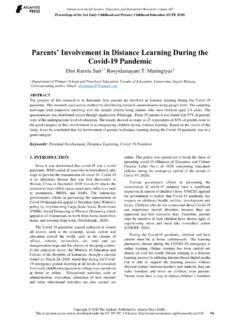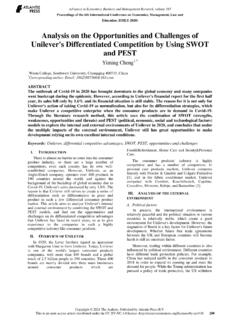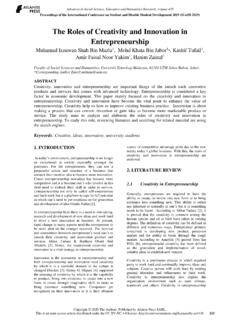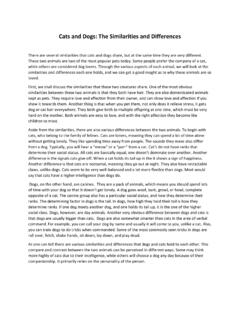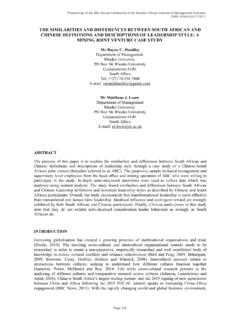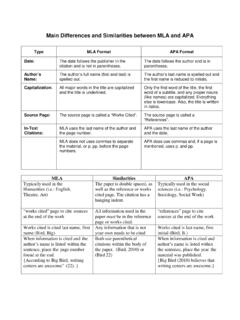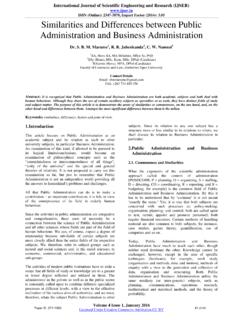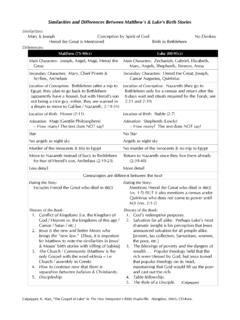Transcription of Language and Gender: Differences and Similarities
1 Language and Gender: Differences and Similarities Lihong Gu Foreign Language Teaching Department, Hebei Finance University , Hengxiang St. Baoding, Hebei Province, China Abstract The relationship between gender and Language has been studied with main focus on Differences between the Language of male and female from different angles with different methodologies. The research findings lay different emphasis on the Differences , but there are some problems in the researches. This paper will review the previous researches into gender Differences , then point out the problems existing in methodology and research findings, and finally propose that researchers should pay more attention to the Similarities between the Language of both genders, the Similarities play the same important part as well as Differences .
2 Keywords: Language , gender, Differences , Similarities 1. Introduction Language and gender refers to the relationship between the Language of male and female. Gender difference is not only a reflection of the speeches between male and female, but also a reflection of their different living styles and attitudes. Gender difference is a popular research in many fields, such as in psychology, in sociolinguistics, and in female study. In these fields, the Differences between male and female in many aspects have been studied from different angles with different methodologies. Though research findings lay different emphasis on the Differences , there are still some Similarities between them.
3 For instance, males are more concerned with power, they desire to be leaders, while females are satisfied with their subordinate status; males speak directly and take transferring information as the first thing, but females speak indirectly, implicitly and mildly. For them, expressing feelings is very important. Many scholars have concerned about the Differences between the Language of male and female. To some extent, it shows that gender difference is very popular and important. This paper will focus on gender Differences and Similarities . Firstly, the previous researches into gender Differences are reviewed, then, some problems existing in research methodology and research findings are pointed out, and finally some suggestions are put forward that researchers should pay more attention to the Similarities between the Language of male and female, the Similarities play the same important part as Differences in research.
4 2. Review of the researches into gender and Language The Beginning of the research Early in the 1970s, linguists, psychologists began to attach great importance to Differences between the Language of male and female, the representatives were Key, Lakoff and Thorne. The mainstream views include the deficit theory by Lakoff (1975), who considers that female Language is inferior to male Language , the dominance theory by Thorne(1975), who thinks female Language is superior, male Language is a kind of deficiency, and Cameron (2003) put forward that women are better at listening and sharing emotions with others. They put forward some terms, such as women s Language (Lakoff, 1973), the female register (Grosby and Nyquist, 1977), genderlect (Kramer, 1974) and gender-related- Language (Mulac et al, 1986).
5 The scholars use different terms to determine their research subject. No matter what angles they researched from and what methodology they used, the scholars promote the development of the research into gender Differences . The research into gender Differences in the field of linguistics began with Robin Lakoff. She put forward female Language and her book Language and Women s Place published in 1973 aroused the linguists interests in this research topic. Lakoff points out several features of the female Language in her book. (1) Specialized vocabulary. Compared with the Language of 2013 International Conference on Advances in Social Science, Humanities, and Management (ASSHM 2013) 2013.
6 The authors - Published by Atlantis Press248 males, females often like to use more concrete color words, such as mauve, yellow, azure, beige and lavender. What s more, they prefer to some concrete words that have a close relationship with life. (2) Milder expletives. Females use expletives in a milder tone, but males often speak in a strong tone. For example, in Friends, Joe and Chandler often say shit or damn it , while female actresses often use milder expletives, like go to hell . The control of social conventions may lead to the different ways of speaking. (3) Empty adjectives. Females always use some adjectives, such as charming, divine, and cute to express their feelings. (4) Tag questions.
7 Though males and females both use tag questions in a certain situation, females use tag questions specially, that is to say, when they express their opinions, tag questions are their favorite way of speaking even they are sure about what they want to say. Their purpose is to show they want to get recognized by others. (5) Intonation. Females prefer to a rising tone even in a declarative sentence, so their uncertainty and indecision have been revealed by a rising tone. (6) Superpolite forms. Females are more polite than males. They tend to prefer an indirect way of speaking. A case in point is I was wondering whether it was possible for you to hand me that book? (7) Hypercorrect grammar.
8 Females usually speak in a formal manner not only in grammar, but also in pronunciation. They never use such words as ain t , goin . (8) Joke-telling and humor. The Language of female lacks humor; they speak less humorously than males. Females inherently are not good at creating humor and understanding humor. For instance, we have known the famous classic and comic characters like Mr. Bean and Chaplin but female comic characters can never be found to equate with them. The situation is the same in China, Zhao Benshan, Guo Degang and Zhou Libo has gained more popularity than any females. Lakoff held that the Differences in lexicon, syntax and pragmatics mentioned above give us a unique style of the Language of female: obedient, uncertainty and passive.
9 Their speaking style is determined by the requirements of the society for females and their subordinate social status. Later study into this research topic Lakoff's research has a great influence on the later linguists research. In the field of linguistics, the Differences between the Language of both genders have been studied in Anthropology, Dialectology, and Sociolinguistics. In Jennifer Coates s view, the anthropologists regard Language as a part of the social behavior of a certain social community. The dialectologists research into the changes of Language and the decline of some dialects by analyzing the Language of some community.
10 Sociolinguists look gender as a social variable to study the relationship between Language and gender. From their complicated understanding and researches, we can draw a conclusion that the researchers concerned about the Differences between the languages of both genders in common. In Anthropology, the researchers focus on Differences in phonology and lexicon, etc. Flannery found the pronunciation of female is different from that of male to a great degree in the two tribes Montana and Gros Ventre. Males use / / at the place where females use / /. In this Language community, pronunciation is regarded as a sign of sex. So if males speak in the way of a female or females speak in the way of a male, he or she will be looked on as a bi-sexual.




